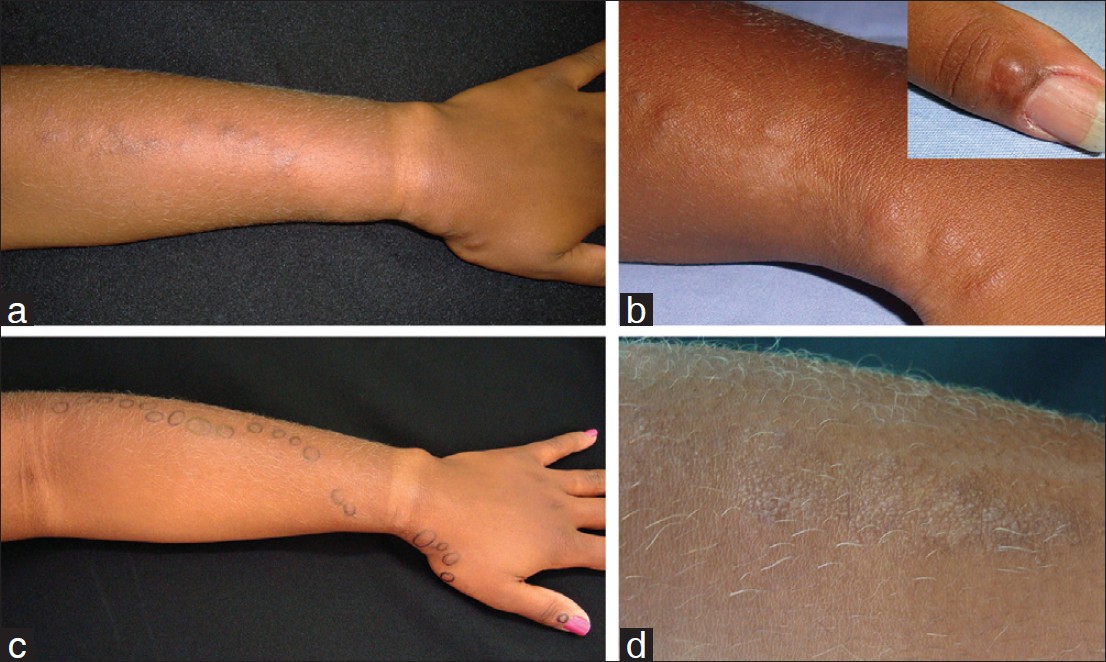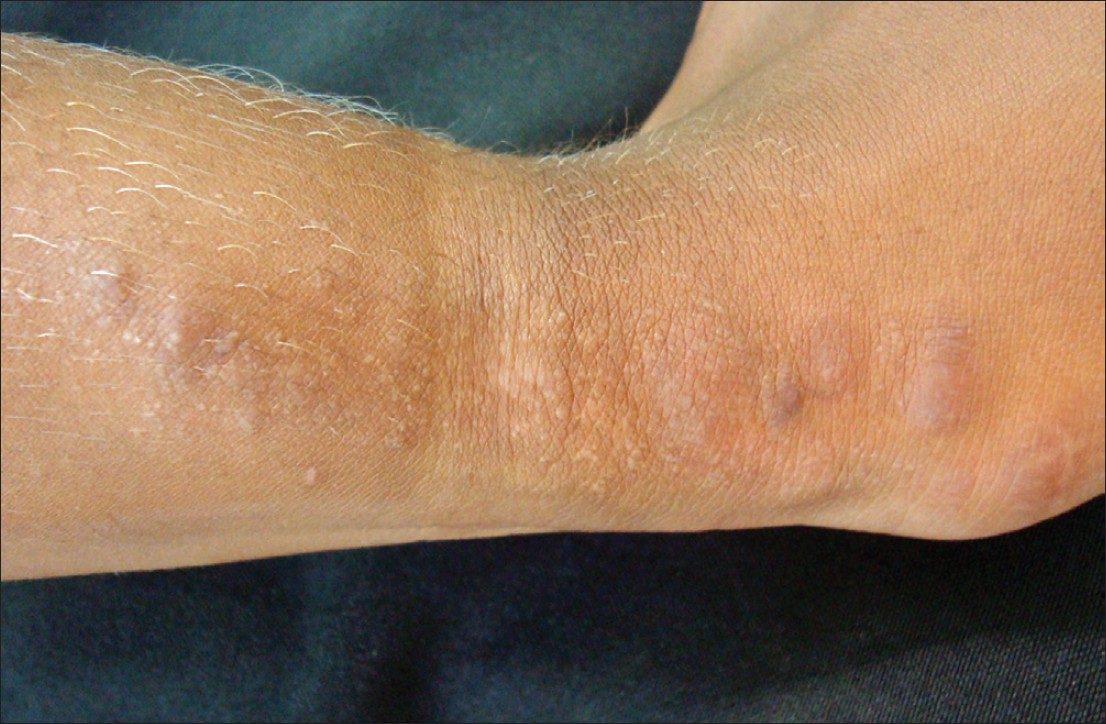Translate this page into:
Multiple cutaneous reticulohistiocytomas along the lines of Blaschko associated with lichen striatus
Correspondence Address:
Bruno Sim�o dos Santos
Rua Marques de Paran� 303, Niter�i - Rio de Janeiro
Brazil
| How to cite this article: dos Santos BS, Guedes Vilar EA, Freitas PM, Barbosa Dur�es SM, Estrella E. Multiple cutaneous reticulohistiocytomas along the lines of Blaschko associated with lichen striatus. Indian J Dermatol Venereol Leprol 2013;79:251-252 |
Sir,
Reticulohistiocytosis belongs to the group of non-Langerhans cell histiocytic disorders, which are characterized by the accumulation of histiocytes that do not represent the phenotype of Langerhans cells.Reticulohistiocytosis is characterized by dermal histiocytic infiltration of large, eosinophilic histiocytes with a "glassy" cytoplasm,and represents a spectrum of rare clinical entities: the solitary cutaneous form; the diffuse-cutaneous type without systemic involvement; and multicentric reticulohistiocytosis. [1],[2] Here we describe the case of multiple cutaneous lesions of reticulohistiocytoma with a distinct clinical presentation.
A 15-year-old girl presented with asymptomatic lesions that had developed over a period of 5 months on her left upper limb. She had no remarkable personal or family history of diseases and no other related symptoms. During physical examination, multiple erythematous, hyperchromic, and firm nodules varying in size (10-15 mm) were observed on the posterior surface of her left forearm, dorsum of the hand, and thumb along the lines of Blaschko. Furthermore, in the same topography, we noticed small hypochromic, isolated, and grouped papules and hypochromic macules over the nodular lesions [Figure - 1] and [Figure - 2]. Routine laboratory investigations showed no abnormalities. Histopathological examination of three nodules with hypochromic lesions on the overlying skin was performed, and all lesions showed the same features. Hematoxylin-eosin staining showed psoriasiform acanthosis, mild exocytosis of lymphocytes, and isolated keratinocyte necrosis in the epidermis. Focal lymphocytic infiltrate and focal vacuolar degeneration of the basal cell layer were seen at the dermal-epidermal junction. In addition, a dense dermal infiltrate, predominantly composed of large histiocytes and multinucleated giant cells with granular, eosinophilic, and ground-glass cytoplasm, was also noted. These histiocytes were positive for periodic acid-Schiff (PAS)-diastase. No Touton giant cells were present. Interestingly, lymphocytic infiltration of glandular ducts and eccrine glands was also observed [Figure - 3]. Immunohistochemical analysis showed that the histiocytes were positive for CD68 and vimentin, but negative for CD1a, factor XIIIa, and S-100 protein. Based on these findings, the diagnosis of reticulohistiocytomas associated with lichen striatus was made. The lesions were clinically stable during the 2-year follow-up period.
 |
| Figure 1: (a) Nodular lesions located along the lines of Blaschko on the hand and forearm. (b) Erythematous nodules on the proximal nail fold, hand, and forearm. (c) Demarcated lesions highlighting the topography. (d) Hypochromic papules over the forearm nodular lesions |
 |
| Figure 2: Nodules and hypochromic papules and macules in the same topography |
 |
| Figure 3: (a) Psoriasiform acanthosis and focal lymphocytic infiltrate at the dermal-epidermal junction (H and E, ×100). (b) Diffuse infiltration of the dermis with large, eosinophilic histiocytes (H and E, ×100). (c) Lymphocytic infiltrate involving the eccrine gland (H and E, ×200). (d) Histiocytes with ground-glass cytoplasm positive for PAS-diastase (×400) |
Lichen striatus is an uncommon dermatosis with a striking linear distribution. It is most frequent in children. [3] Typically, lichen striatus is characterized by the presence of erythematous, lichenoid papules that generally develop along the lines of Blaschko, although hypopigmented macules and/or papules may occur in dark-skinned people. [4] Some histopathological findings of lichen striatus include hyperkeratosis, necrotic keratinocytes in the epidermis, mild spongiosis with exocytosis of lymphocytes, and focal or lichenoid lymphocytic infiltrate at the dermal-epidermal junction. Perivascular lymphocytic infiltration may also occur, and there may be involvement of hair follicles and/or eccrine glands. [3] Lichenoid epidermal change and a disturbed basal cell layer were found in some cases of solitary reticulohistiocytoma. However, there is no mention of lymphocytic infiltration of eccrine glands in such cases. [2] Moreover, hypochromic papules and macules have not been reported as clinical manifestations of reticulohistiocytoma. [1],[2] Thus, based on the clinico-pathological correlation, we believe that hypochromic macules and papules observed in this case best correspond to lichen striatus lesions associated with reticulohistiocytoma, which manifested as nodular lesions. Coexistence of lichenoid and granulomatous dermatitis in the same lesion has been reported. A single case of lichen planus associated with multicentric reticulohistiocytosis has been described. [5] Nonetheless, to our knowledge, this is the first report of multiple reticulohistiocytomas showing a Blaschko-linear distribution. Moreover, the coexistence of reticulohistiocytoma and lichen striatus has never been described in the medical literature so far.
| 1. |
Zak FG. Reticulohistiocytoma ('ganglioneuroma') of the skin. Br J Dermatol 1950;62:351-5.
[Google Scholar]
|
| 2. |
Caputo R, Marzano AV, Gianotti R. Asymptomatic nodule on the upper lip. Arch Dermatol 2003;139:381-6.
[Google Scholar]
|
| 3. |
Zhang Y, McNutt NS. Lichen striatus: histological, immunohistochemical, and ultrastructural study of 37 cases. J Cutan Pathol 2001;28:65-71.
[Google Scholar]
|
| 4. |
Patrizi A, Neri I, Fiorentini C, Bonci A, Ricci G. Lichen striatus: clinical and laboratory features of 115 children. Pediatr Dermatol 2004;21:197-204.
[Google Scholar]
|
| 5. |
Magro CM, Crowson AN. Lichenoid and granulomatous dermatitis. Int J Dermatol 2000;39:126-33.
[Google Scholar]
|
Fulltext Views
2,831
PDF downloads
1,276





